Hard Disk Drives with HAMR Technology Set to Arrive in 2018
by Anton Shilov on December 24, 2015 9:00 AM EST- Posted in
- HDDs
- Seagate
- Toshiba
- Western Digital
- HGST
- HAMR
- Showa Denko
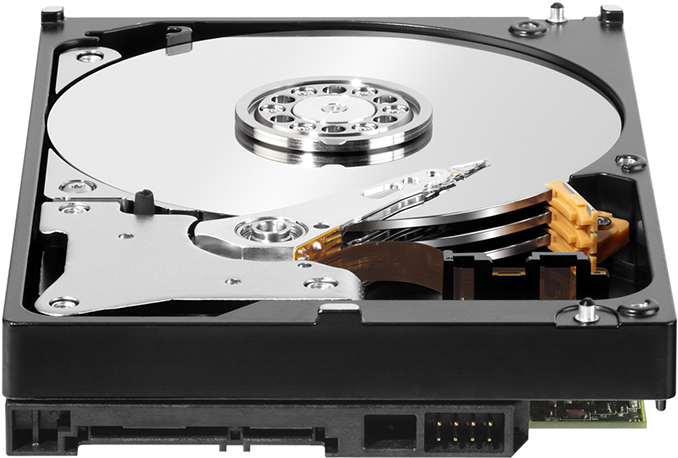
While many client devices use solid-state storage technologies nowadays, hard disk drives (HDDs) are still used by hundreds of millions of people and across virtually all datacenters worldwide. Heat-assisted magnetic recording (HAMR) technology promises to increase capacities of HDDs significantly in the coming years. Unfortunately, mass production of actual hard drives featuring HAMR has been delayed for a number of times already and now it turns out that the first HAMR-based HDDs are due in 2018.
Storage Demands Are Increasing
Analysts from International Data Corp. and Western Digital Corp. estimate that data storage capacity shipped by the industry in 2020 will total approximately 2900 exabytes (1EB = 1 million TB), up from around 1000EB in 2015. Demand for storage will be driven by various factors, including Big Data, Internet-of-Things, user-generated content, enterprise storage, personal storage and so on. Samsung Electronics believes that the NAND flash industry will produce 253EB of flash memory in 2020, up from 84EB in 2015. Various types of solid-state storage will account for less than 10% of the storage market in terms of bytes shipped, whereas hard drives, tape and some other technologies will account for over 90%, if the estimates by IDC, Samsung and Western Digital are correct.
In a bid to meet demand for increased storage needs in the coming years, the industry will need to expand production of NAND flash memory as well as to increase capacities of hard disk drives. Modern HDDs based on perpendicular magnetic recording (PMR) and shingled magnetic recording (SMR) platters have areal density of around ~0.95 Terabit per square inch (Tb/in²) and can store up to 10TB of data (on seven 1.43TB platters). Technologies like two-dimensional magnetic recording (TDMR) can potentially increase areal density of HDD disks by 5 to 10 per cent, which is significant. Moreover, Showa Denko K.K. (SDK), the world’s largest independent maker of hard drive platters, has outlined plans to mass produce ninth-generation PMR HDD media with areal density of up to 1.3Tb/in² next year.
HAMR: The Key to Next-Gen HDDs
Companies like Seagate Technology and Western Digital believe that to hit areal densities beyond 1.5Tb/in², HAMR technology along with higher anisotropy media will be required because of supermagnetic limit (physical “pitches” on optical media become so tiny that it will not be possible to produce a powerful enough magnetic field in the HDD space to write data into them).
Certain principles of heat-assisted magnetic recording were patented back in 1954, even before IBM demonstrated the very first commercial hard disk drive. Heat-assisted magnetic recording technology briefly heats magnetic recording media with a special laser close to Curie point (the temperature at which ferromagnetic materials lose their permanent magnetic properties) to reduce its coercivity while writing data on it. HAMR HDDs will feature a new architecture, require new media, completely redesigned read/write heads with a laser as well as a special near-field optical transducer (NFT) and a number of other components not used or mass produced today.
According to Seagate, its HAMR heads heat media to approximately 450°C using a laser with 810nm wavelength and 20mW power. The company does not disclose any details about its HAMR recording heads because they are the most crucial part of the next-generation hard drives. HDD makers, independent producers of recording heads, universities and various other parties have researched HAMR heads for years. NFT is a very important components of any HAMR head. It has to deliver the right amount of energy into a spot diameter of 30nm or smaller. NFT also has to be durable and reliable, which is something that many researchers are working on.
This month Showa Denko disclosed its roadmap for next-generation hard drive media. While such plans tend to change as products get closer to mass production, at present SDK expects its first 2.5” platters for HAMR drives to feature 1.2TB – 1.5TB capacity (areal density of 1.5Tb/in² – 1.95Tb/in²). By the end of the decade, capacity of 2.5” disks for HDDs is projected to increase to 2TB. Showa Denko’s forecasts clearly show the benefits of HAMR technology and its potential.
In Development for Years
Manufacturers of hard disk drives, heads and HDD media have been working on technologies to enable HAMR-based HDDs for well over ten years now, as soon as they realized that at some point HAMR technology would be required to build hard drives with higher capacities.
Starting from mid-2000s, various manufacturers of HDDs have demonstrated prototype HDDs that used HAMR technology for a number of times. For example, Western Digital showcased a 2.5” hard drive that used HAMR tech back in late 2013. In mid-2015, Seagate displayed a NAS powered by multiple drives featuring heat-assisted magnetic recording.
Numerous demonstrations of HAMR-based HDDs in action prove that the technology actually works. Over the years, producers of hard drives, platters and recording heads have revealed various possible timeframes for commercial availability of drives with HAMR technology. Their predictions were not accurate. At present, there are still reliability issues with the technology, according to Seagate. In the recent months both Seagate and Showa Denko indicated that HAMR drives would be delayed again.
Still Not Ready for Commercial Products
Seagate plans to ship prototypes of its HAMR-based drives to select customers in late 2016 or early 2017. The drives will be intended mostly for test purposes. They will help Seagate and the company's clients to understand how reliable the HAMR-powered HDDs are in actual datacenters, whether they are compatible with existing infrastructure and how fast they are in real-world applications. Evaluation will take a long time and chances that Seagate starts volume shipments of hard disk drives with HAMR technology in 2017 are low.
Last week Showa Denko also said that its platters for hard disk drives that use heat-assisted magnetic recording technology would be delayed to 2018.
“As for new generation technologies, HAMR or TAMR, the start of mass production will be [slightly] delayed to 2018,” said Hideo Ichikawa, president of Showa Denko. The official mid-term business plan of the company reads that the new-generation media "will be launched in or after 2018".
While it is evident that HAMR-powered hard drives are not ready for prime time, producers of HDDs do not reveal the nature of the issues. Seagate indicated earlier this year that HAMR-based drives were not stable enough, but did not elaborate.
Higher-Capacity HDDs Are Incoming
Even though HAMR seems to be at least two years away, hard drive makers will continue to increase capacities of their flagship drives going forward.
SDK promises to start volume production of its ninth-generation perpendicular magnetic recording platters next year. So far, the company has announced that the ninth-gen PMR disks for 2.5” HDDs will feature 1TB capacity. Eventually the tech could be applied to 3.5” platters to increase their capacity up to around 2TB.
Earlier this year Seagate introduced its 2TB hard disk drive in 2.5” form-factor that is just 7mm thick. The drive is based on two 1TB platters, which feature leading-edge 1.3Tb/in² areal density. The same technology will inevitably be used for 3.5” HDDs, enabling Seagate to introduce enterprise-class hard drives with over 10TB capacity in the coming years.
Western Digital Corp. builds high-capacity platters in-house. While exact plans of the company are unclear, its HGST division has consistently offered the world’s highest-capacity hard drives for several years in a row now.
Overall, while HAMR faces another delay, leading producers of hard disk drives will be able to expand capacities of their HDDs using PMR and SMR platters in the coming years.


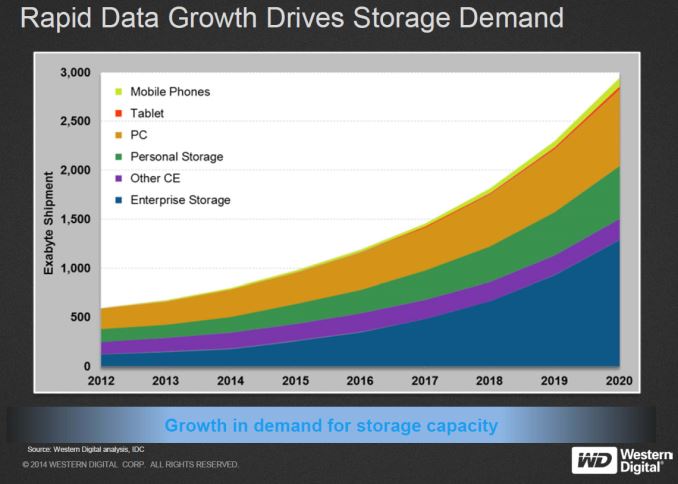
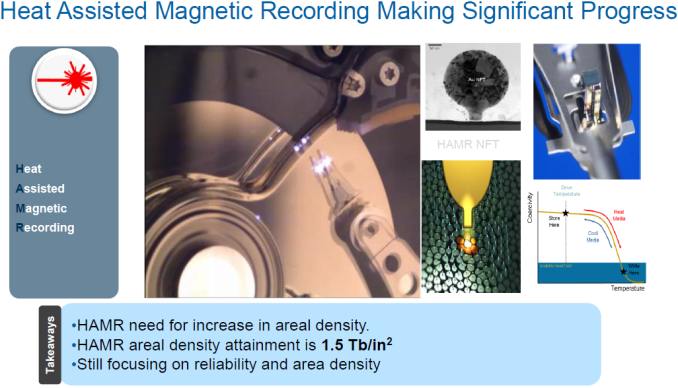
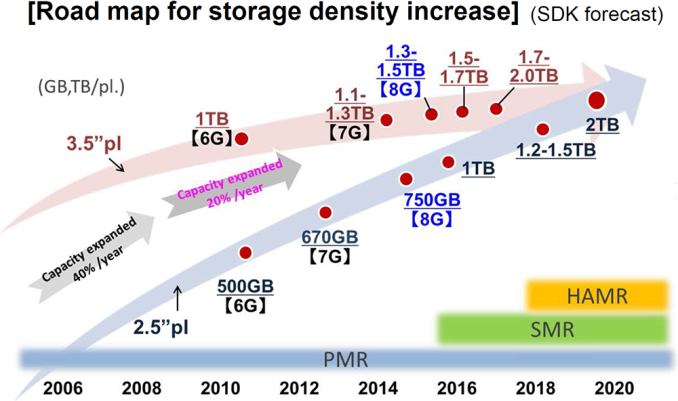
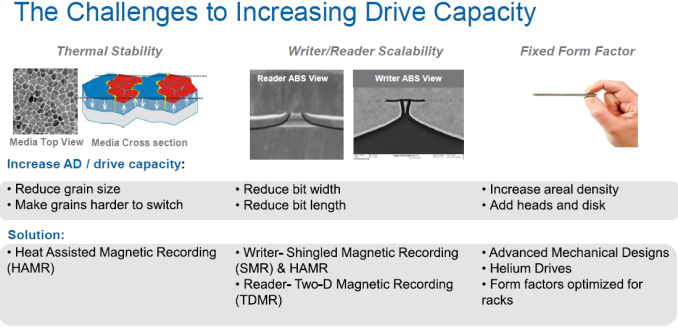
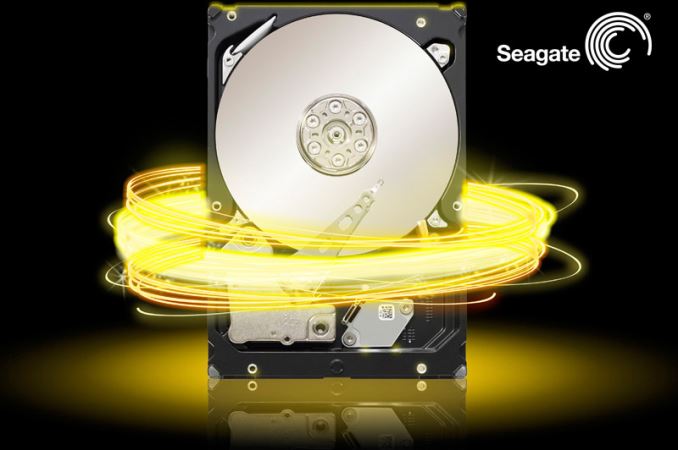
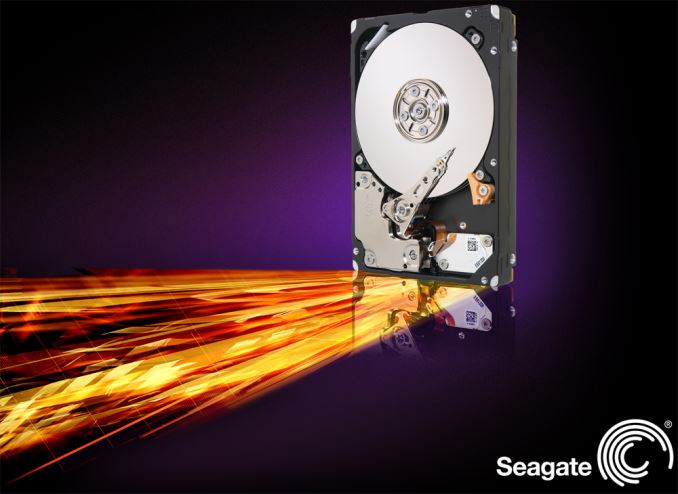








72 Comments
View All Comments
Lord of the Bored - Saturday, December 26, 2015 - link
The same basic idea of using a laser to heat the media so it's less resistant to magnetic change is used, but the actual implementation is very different.MO disks were read with lasers, like a CD/DVD/BRD. These are still read as magnetic disks.
Tangentally, I still wish MO disks had replaced floppies instead of CD-RW. I remember when the first MiniDisks hit in the early 90s how great a floppy they would make(and then Sony ignored the possibilities as their music division shot themselves in the foot repeatedly).
Michael Bay - Sunday, December 27, 2015 - link
Between MiniDisc and those zipdrives, absolutely.HerveS94 - Friday, December 25, 2015 - link
Interesting to ee this new technology about HDDs, so i am looking forward to seeing new storage tdch being implemented into this, it also looks very promising.SydneyBlue120d - Friday, December 25, 2015 - link
Do You think it will be possibile to sse SSHD using HAMR + Intel Optane ?Scoobmx - Friday, December 25, 2015 - link
I believe it's superparamagnetic limit, not supermagnetic limit, but maybe you are referring to something unrelated.DesktopMan - Saturday, December 26, 2015 - link
Unless HDD speeds catch up to this storage increase they will still be left behind. It already takes way too long to rebuild RAID arrays based on 2TB or larger disks.The12pAc - Sunday, December 27, 2015 - link
I think this a non-issue anymore since storage controller (at least most enterprise-class) are controlling the placement of bit for redundancy instead of the traditional RAID controller. My Compellent SAN will allow for all versions of RAID depending on how much redundancy/speed the customer wants. This illiminates the rebuild factor.Amazing2u - Saturday, December 26, 2015 - link
2 things I would like to see happen in this decade:- Smart phones with a high performance CPU/GPU that will last more than a day on a charge
- a hard disk drives with a high storage capacity that is RELIABLE!!!
stang725 - Sunday, December 27, 2015 - link
If and when 450mm memory FABs come online, you might eventually see the bi-modal price per GB merge, but not without 450mm. Platter-based storage and NAND are too far apart in terms of their manufacturing inputs for them to ever be at the same price, outside of putting more chips on a wafer and maintaining the yields on a larger wafer. Semicon is already close to the bottom-end of how small you can go in terms of the patterning (light-source limitations) to hope for any huge gains in chip density anytime soon, at least not without a huge jump in FAB equipment costs. Also, a 450mm FAB would not be cheap and would have to built from the ground up (talking billions of USD). I would be happier with just faster NAND/mem controllers/interfaces... the need for the AVERAGE 2015 PC user for more than 4TB of storage is not really there, especially with cloud storage.ppi - Monday, December 28, 2015 - link
Cloud storage is not an answer1) Cloud storage providers need to store their data somehow as well
2) Did you compare cloud storage prices vs. cost of NAS? Not pretty for longer than 1 year.
3) Local storage will always be faster than any cloud solution. I would admit at certain point it can reach "fast enough" speeds.
4) What "average" user needs quite develops over time. There was time I thought my 120 MB HDD is all I will ever need. Did you factor in 4K videos, 100 GB games, etc. in that figure?